Blue Diamonds Wiki
- Home /
- Diamond Education /
- Blue Diamonds Wiki
Colored diamonds are much like snowflakes - a natural phenomenon of which no two are completely alike. Each boasts a unique shade and set of characteristics, but they do have two things in common: a stunning appearance, and a remarkable rarity.
Among the most rare are blue diamonds. In fact, if we'll divide the rarity scale of colored diamonds into four groups, blue diamonds will be at the tip of the second rarest - more rare than pinks but less than red, violet and purple. Though we need to remember that not all blue diamonds are equally rare, the strongest the color, the more rare the diamond.
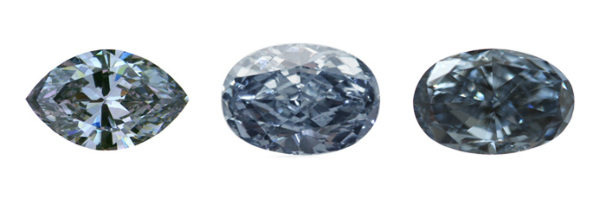 Shades of Blue Diamonds – Fancy, Intense and Deep Blue
Shades of Blue Diamonds – Fancy, Intense and Deep Blue
According to "The Fancy Color Diamond Book" by Eden Rachminov, less than one-tenth of a percent of all fancy colored diamonds are Type IIb blues. Moreover, the Natural Color Diamond Association reported that only one natural blue diamond can be found on the market for every 100 Picasso paintings up at auction.
There is more to these gems than meets the eye, though. An unusual chemical makeup and rich role in history make blue diamonds some of the most fascinating stones in existence.
Here's some interesting information that any diamond enthusiast should know.
About the Blue Color
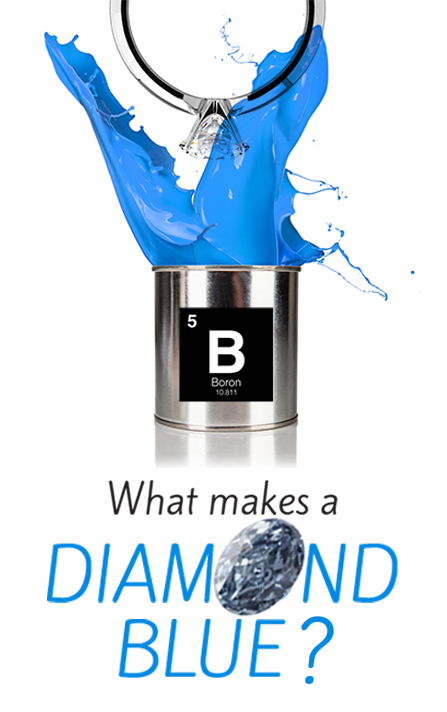 Boron causes the blue color
Boron causes the blue color
There's a scientific cause for appearance of colors in diamonds: the presence of an impurity. This is also true for blue diamonds.
In "The Fancy Color Diamond Book," they explain that while a diamond is forming, boron particles can become trapped inside the crystal lattice. It is this substance that absorbs yellow light, thus reflecting a blue color.
Like any other colored diamond, blue stones can exhibit a wide range of hues, from pale shades that mimic a clear sky, to steel blue, to an intense deep sea. It's common to see blue diamonds listed with more specific names regarding their shade, such as baby, royal, navy or midnight.
Blue Diamond Types
Most pure blue diamonds are Type IIb, meaning they either very few or a complete lack of nitrogen impurities. Type Ia blue stones, on the other hand, which contain a secondary hue, get their color from the presence of hydrogen.
The modifying color will be referred to in their gemological grading reports. For example, one of these stones might be classified as gray-blue or greenish-blue. There's another trait that sets blue diamonds apart: These stones are the hardest conductors of both heat and electricity on Earth. Sciences 360 noted that only natural blue diamonds have this capability, and any that have been chemically altered or heated for artificial coloring (color enhanced diamonds) are not conductors.
Where do Blue Diamonds Come From?
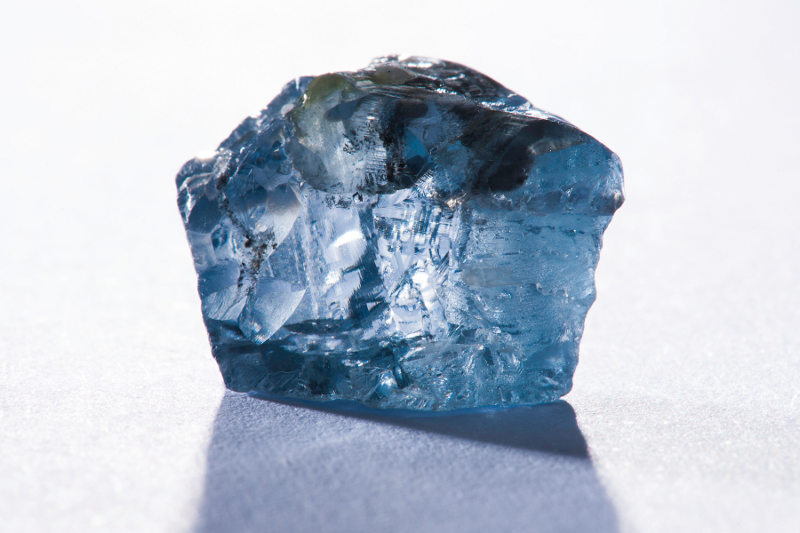 29.6 carat Rough Blue Diamond by Petra
29.6 carat Rough Blue Diamond by PetraImage courtesy of Petra Diamonds
The primary source of blue diamonds is inarguably the Cullinan Mine near Pretoria in South Africa. In fact, the Cullinan Mine which is owned by Petra Diamonds has been the source for the most interesting discoveries (and sales) of blue diamonds in the last few years including the 29.6 carat blue diamond that was sold for $25 Million in the rough.
The same diamond that was just polished into a 12 carat vivid blue named the blue moon.
Another interesting discovery is of the largest blue diamond ever, a 122.52 carat blue diamond.
While it is less common to discover these stones in other locations, they have been unearthed elsewhere, including the Golconda mine in India and the Lesteng mine in Lesotho. It's interesting to note that blue diamonds only typically fluoresce if they were found in Zimbabwe, according to The NCDIA.
In terms of the polishing of fancy blue diamonds, the NCDIA reported that the Israeli market is at the forefront of the manufacturing, especially for polished stones up to 3 carats. Blue gems weighing more are typically manufactured in New York or Antwerp, the source explained.
Value of Blue Diamonds
Due to the diminishing supply and increasing demand for blue diamonds, it goes without saying that they don't come at a low cost. The NCDIA recently reported that prices for natural blue diamonds has been gradually and consistently rising between 12 and 17 percent every year over the past decade, regardless of the saturation level. A fact that we can easily suport based on personal experience.
So while fancy vivid blue diamonds may be less commonly found and more highly sought-after, even fancy light blue diamonds are being sold for jaw-dropping prices.
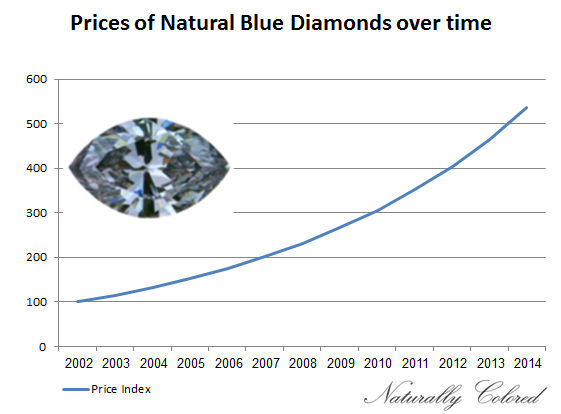 Illustration of Natural Blue Diamonds prices over time
Illustration of Natural Blue Diamonds prices over timebased on data from the NCDIA
The source estimated that vivid blue stones weighing more than 3 carats (the same diamonds that are usually sold at the auctions) fetch $1 million per carat or more. In fact, in recent years, we have seen repeated record-breaking sales of blue diamonds at auctions as collectors and investors eagerly seek to capitalize on these stones. These sales are particularly significant as, the NCDIA pointed out, only about two to four important blue gems come to market annually. Of course, as with any diamond, the carat weight, clarity and cut of a blue stone will also have an impact on the value.
Famous Blue Diamonds
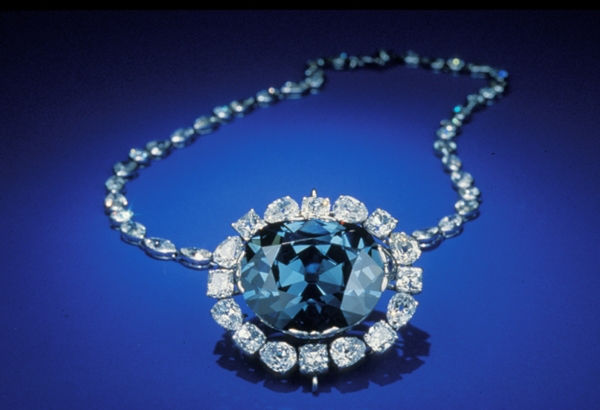 The Hope Diamond
The Hope Diamond
There's no doubt that the Hope Diamond is the most famous blue stone in history (and probably most famous diamond in the world). Jeweller Magazine noted that this fancy dark grayish blue gem, which weighed in at a astounding 45.52 carats, has a long and complex story attached to it, including a number of deaths that have led many to believe it's cursed.
Famous jeweler Harry Winston bought the Hope, but only owned it for a day before donating it to the Smithsonian Natural History Museum.
Other impressive finds have popped up throughout the years. For example, The Star of Josephine, a 7.0-carat cushion-cut fancy vivid blue and internally flawless diamond that was unearthed in 2008, sold at a Sotheby's auction just one year later for $9.49 million - or at $1.35 million per carat. It set a world record at the time for the highest price per carat for any gemstone at auction.
The 42.92-carat pear-shaped Tereschenko diamond is the second largest fancy blue stone in the world after the Hope.
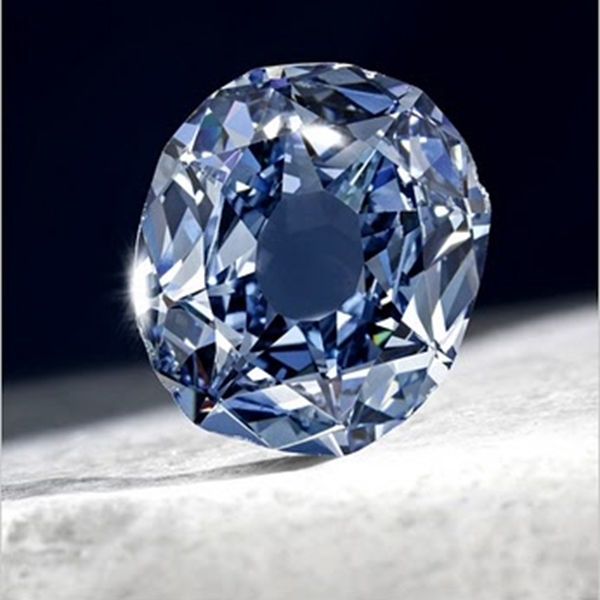 Wittelsbach Diamond
Wittelsbach DiamondImage via Christie's
Of course, one can't discuss blue diamonds without citing the famous Wittelsbach-Graff, which was discovered sometime in the mid-1600s and after being bought, recut and repolished by Laurence Graff, weighs a notable 31.06 carats. It fetched an impressive $24.3 million in 2011.
More recently, though, a 29.6-carat rough blue diamond from Petra sold for a staggering $25.6 million - nearly $1 million per carat. At a Christie's auction during 2014, an Internally Flawless vivid blue pear-shaped stone aptly named The Perfect Blue caused quite a stir - and raked in more than $24.24 million, meaning it almost beat out the Wittelsbach Diamond. Harry Winston, the winning bidder, renamed it the Winston Blue.
